Wolfgang Spahn

Wolfgang Spahn is an Austrian-German visual artist living in Berlin. His work includes interactive installations, miniature slide paintings and performances with light & sound. His art explores the field of analog and digital media, focusing on both their contradiction and correlation. Therefore, he also specializes in the reappropriation and reuse of electronic technologies.
In Spahn's immersive audiovisual performances, the technically different production of images and sounds merges. The data stream of a digital projector becomes audible, while the sound produced by electromagnetic fields of coils and motors is visualized.
Spahn is fascinated by patterns and structures, whether in graphics, photography, video or electronic technology. He seeks to bring out the beauty of disruption, subverting the perfect surface that the contemporary new media industry seeks to achieve.
For his creations, he explores the capabilities of hardware, constantly pushing its limits to put it at the service of his artistic concept. Recently, he has developed and uses analog synthesizers as well as analog computers and analog neural networks to create abstract light and sound sculptures.
Wolfgang Spahn is a faculty member of Sound Studies and Sonic Arts, University of the Arts, Berlin, Germany.
Spahn has presented his work in national and international exhibitions and has also been featured in international media art festivals.
Patagonian Pattern, 2021
The work "Patagonian Pattern" by Wolfgang Spahn is an audiovisual exploration of the mathematical theory of chaos. The focus is on Benoit Mandelbrot's ideas of the self-similarity of fractal structures in nature. The sounds of analogue synthesizers and analogue neural networks complement the visual aspect of the self-similarity of Patagonia's nature, both on a large and macro/microscopic scale.
Electrical signals, for both audio and video, have been generated by analogue circuits based on Strange Attractors, Fibonacci series, chaotic oscillations and feedback loops. In addition, the work shows macroscopic and microscopic patterns, textures and structures of lichens, mosses and algae, superimposed on aerial shots from planes and with kites. The texture of lichen and moss was recorded with laser beams. These modulated waves were converted into sound and additionally used as colour information in video signals.
*Interesting Side Note.
The artwork consists of analog computers, synthesizers and media players that were then poured epoxy resin. There are only two cables, one power supply and one output. The artwork is designed so that you can no longer access the media player. There is no more access to the data. After you connect the artwork, it starts by itself and the video artwork is played. Ergo: A real existing token.
2021, Video art, media player, epoxy resin, monitor with audio speaker.
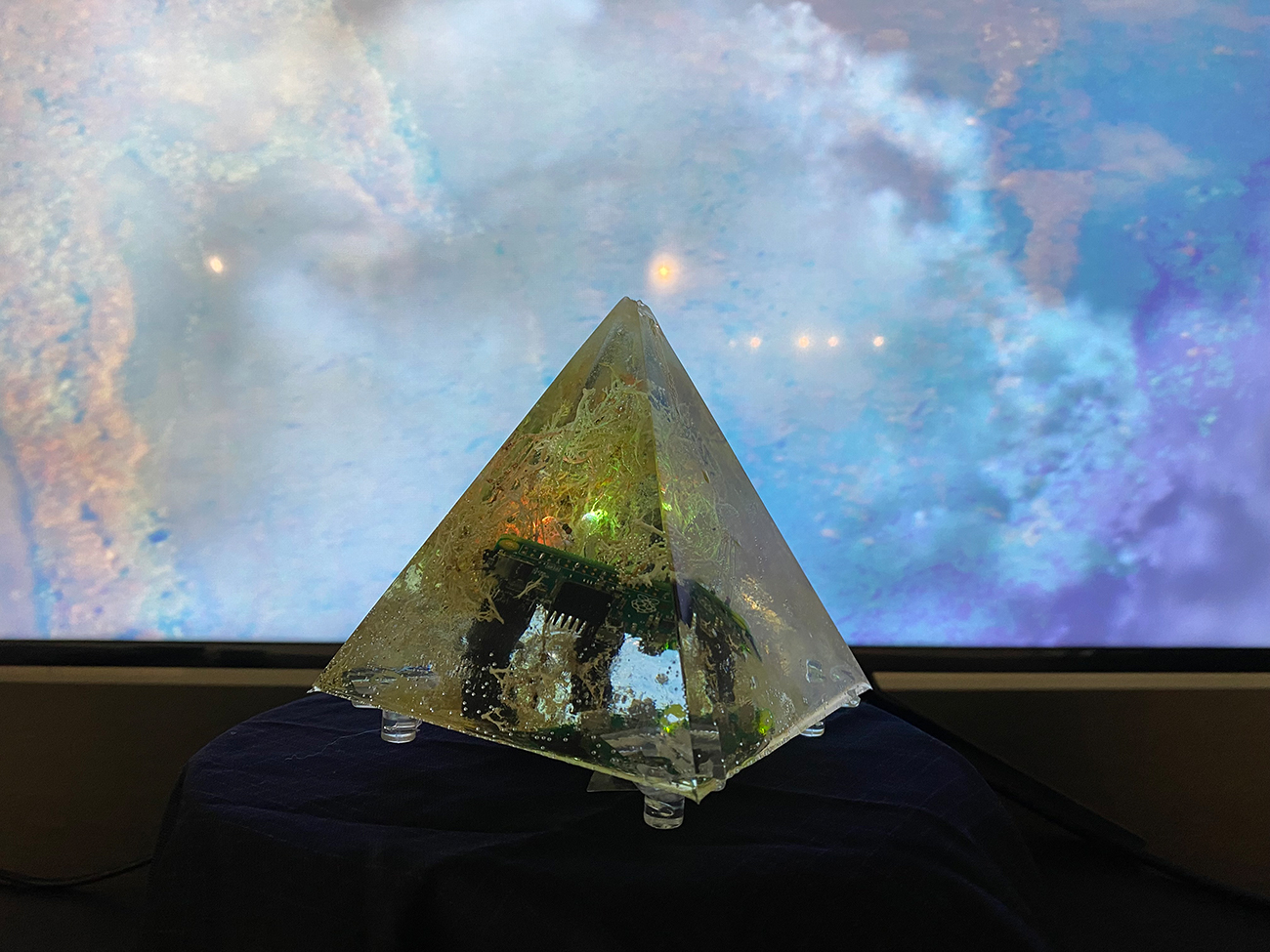
Patagonian Pattern 2021, Courtesy of the Art Claims Impulse
Echo State Network, 2019
https://wolfgang-spahn.de/doku.php/installation:echo_state_networks
the sonification of the computing process in an analog neural network, 2019
The first song a computer intoned was in the 1970s when an IBM 704 at the Bell Labs sang‘ Daisy Bell’. The same song was sung by the artificial intelligence HAL-9000 in the film “2001: A Space Odyssey” by Stanley Kubrick. But why should an AI sang human songs?
Won’t they prefer their own beats and melodies?
The sonic structures produced by the eternal oscillation of analog neural networks is the more possible soundtrack when the technological singularity is reached and AI takes over. At that point in the future, when technology becomes uncontrollable - like the mathematischen John von Neumann predicted in the 1950s - the remains of the human civilization will probably listen to some kind of “Echo State Network”.

Courtesy of the Artist
The installation raises the question: can one hear the firing of neurons? Does their action potential have pitch and timbre? How do patterns and structures of a neural network look and sound? And what will happen if the network listen to these sound and pattern, too - and feeds this information back into the network?
At the core of the sound installation “Echo State Network” by Wolfgang Spahn is an artificial analog neural network that generates sonic pattern and audible structures. The circuit of the neuron is an adaption of an early neural model originally designed by Japanese mathematician Shun'ichi Amari to explain the human heart beats. Thus the factor time and feedback are added to the network. Compared to Facebook and Google networks this neural systems is much more complex and manifold in its appearance. One can say this analog artificial network mirrors far more the chaotic human nature than the digital AI implementations.
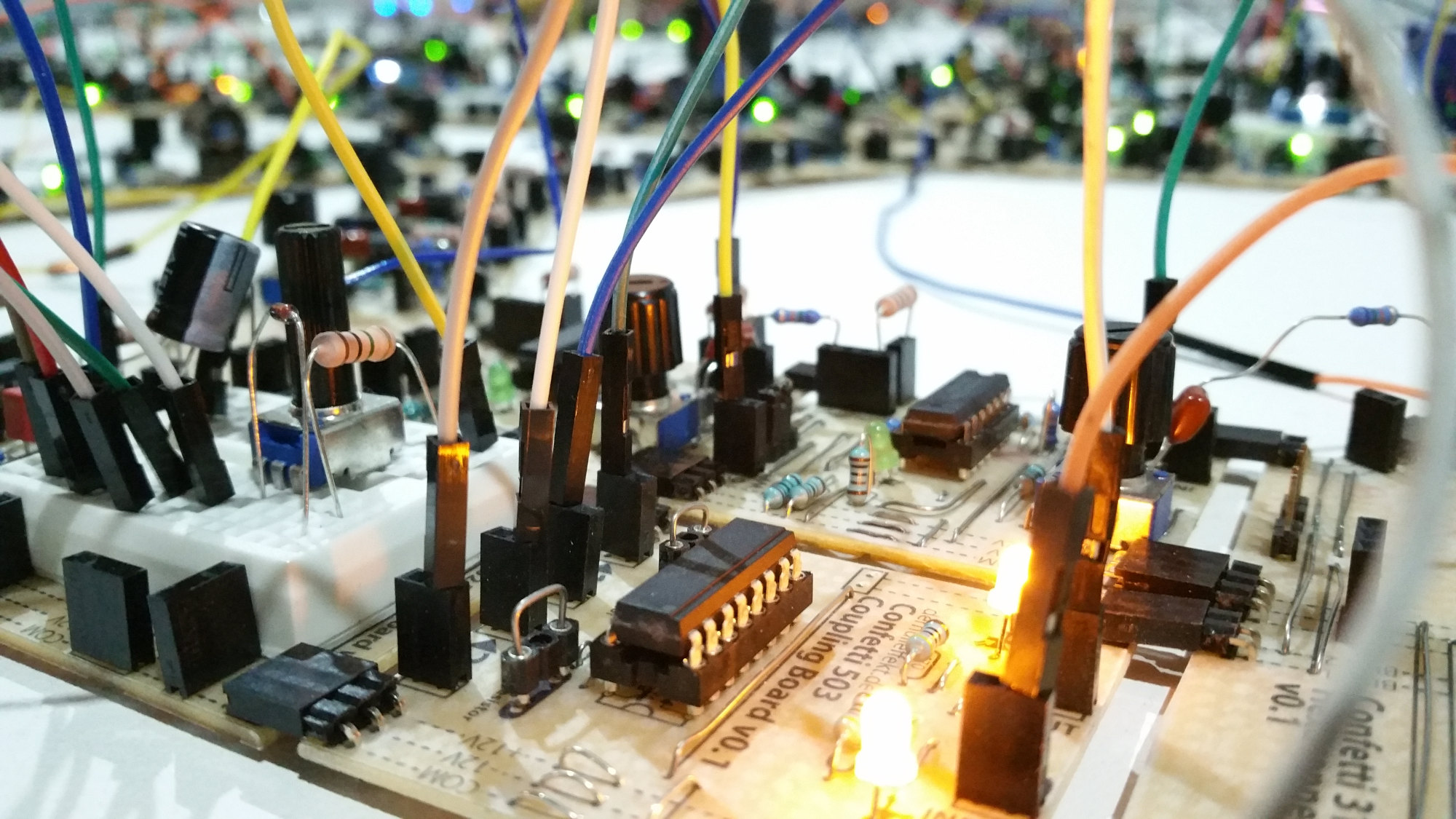
Courtesy of the Artist
As part of his Analog Computer Confetti the artist created an analogue electric circuit that mimic a model of a neuron. More than 150 of the Confetti Neurons will form an analogue version of a so called “Echo State Network”. And because the model for that neuron was developed to explain our heart beat this network will oscillate, pulse and create most complex pattern one can see and listen to.
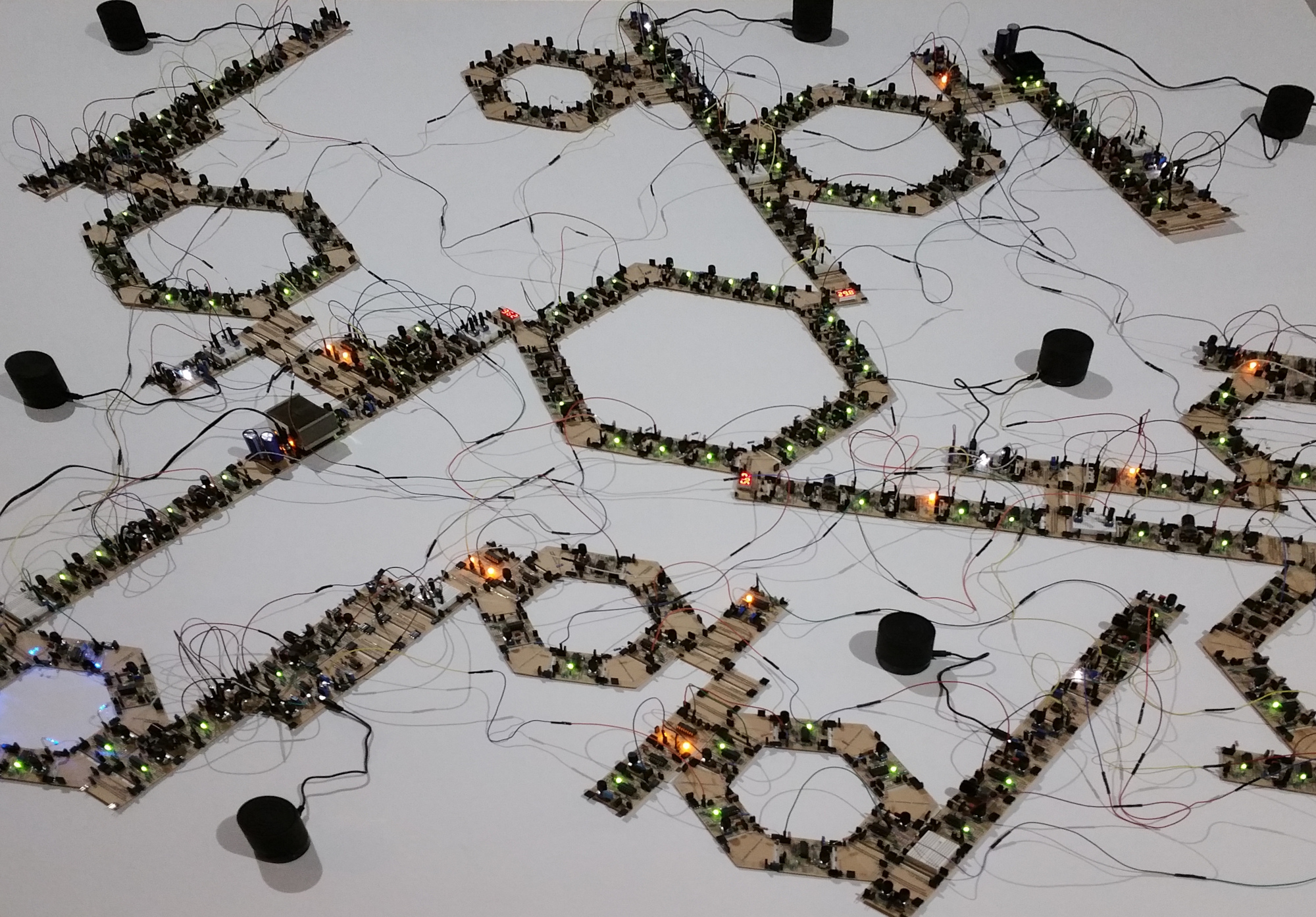
Courtesy of the Artist
An Echo State Network is a particular kind of model of a recurrent neural network. At it‘s core is a complex, chaotic and back coupling neural network, similar to a Liquid-State Machine. At the networks input layer a couple of sensors will react to sound and light. Brightness and frequencies will be processed and fed back in the Echo State Network. A couple of firing neurons that oscillates in a audible frequency will form the output layer. Indicator LEDs shows the action in the network as well as 8 speakers make these activity hearable at 8 different nodes of the network. Thus the visitor can witness the activity in the neural network and can get an idea of the complexity of these processes.
Strange Attractors, 2019
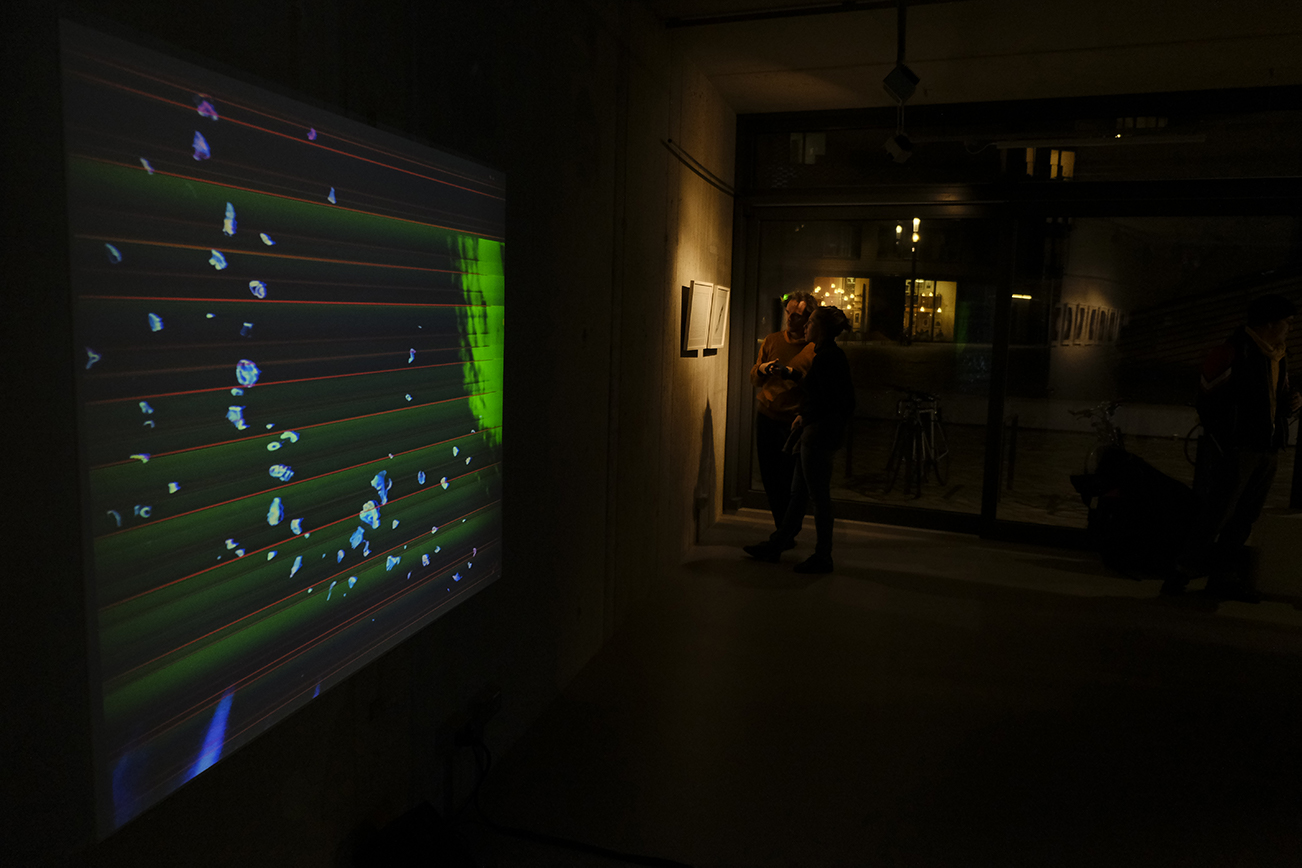
Courtesy Art Claims Impulse
A Lorenz System controlled by an other Lorenz System, 2019
Ever since the mathematician Benoit Mandelbrot geometrically described structures in nature as ‘self-similar systems’ in „How Long Is the Coast of Britain? Statistical Self-Similarity and Fractional Dimension“ a paper published in 1967, fractal structures have remained a subject of artistic enquiry. Strange attractors in their quality of chaotic fractals constitute together with self-similar structures an important part of chaos research, and feature as core and lead theme of the installation.
Courtesy Art Claims Impulse
„Strange Attractors“ is about a generative system for sound and projections based on the analogue computer Confetti (developed by the artist) that calculates these Strange Attractors.
„Strange Attractors” rises the question if climate can be predicted, described by Julia Slingo, and Tim Palmer in Uncertainty in weather and climate prediction.
The title of the work refers to the mathematical term of the same name (David Ruelle / Floris Takens, 1971) borrowed from chaos theory which describes physical laws of chaotic behaviour in dynamic processes. Based on strange attractors it’s possible to for instance to mathematically describe turbulent currents of liquids or gases that cannot otherwise by analytically captured due to their complexity and level of randomness. In the installation two Lorenz Attractors are used to generate the sound as well as the visuals.
Courtesy Art Claims Impulse
The work raised the question of the artistic definition of boundaries in a space which in fact is determined by coincidence. Strange attractors are defined among others by the fact that they always establish a limiting framework or an according order within which the actual chaos can take place. This means that – at least from a mathematical perspective – haphazardness and chaos are enabled by a framework that creates an order, because without this framework any conceivable chaotic system would rise ad infinitum, and by doing so would escape observation and description. If this thought were transferred to art, it would mean that artistically created chaotic systems would not be visible or audible. Accordingly, the installation raises the question whether the artists themselves create the framework that creates the order, allowing the work to emerge ‘haphazardly’. 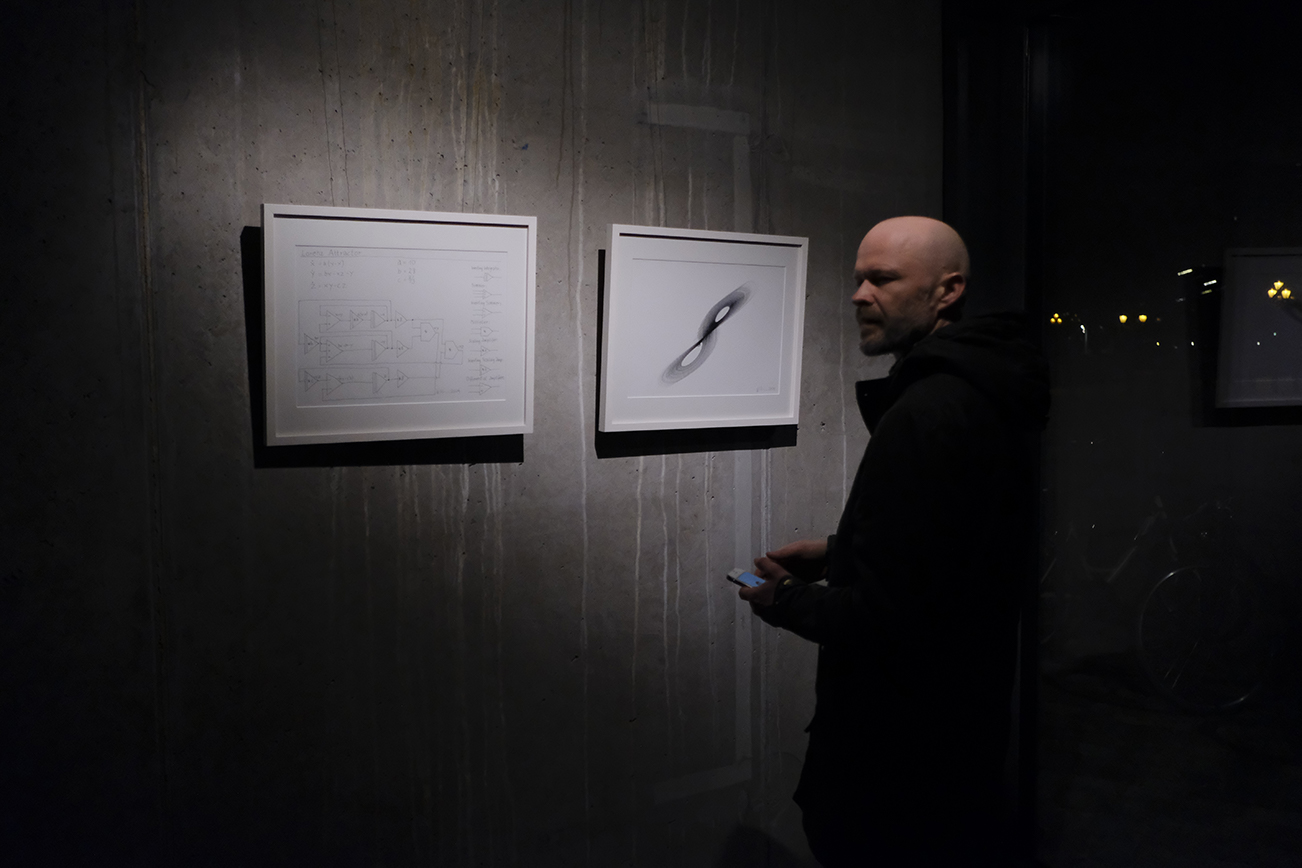
Courtesy Art Claims Impulse
The work was show in the exhibition “Self-Similar and Strange” at Art Claims Impulse in Berlin, 2019.
Its organic if you have a closer look, 2017.
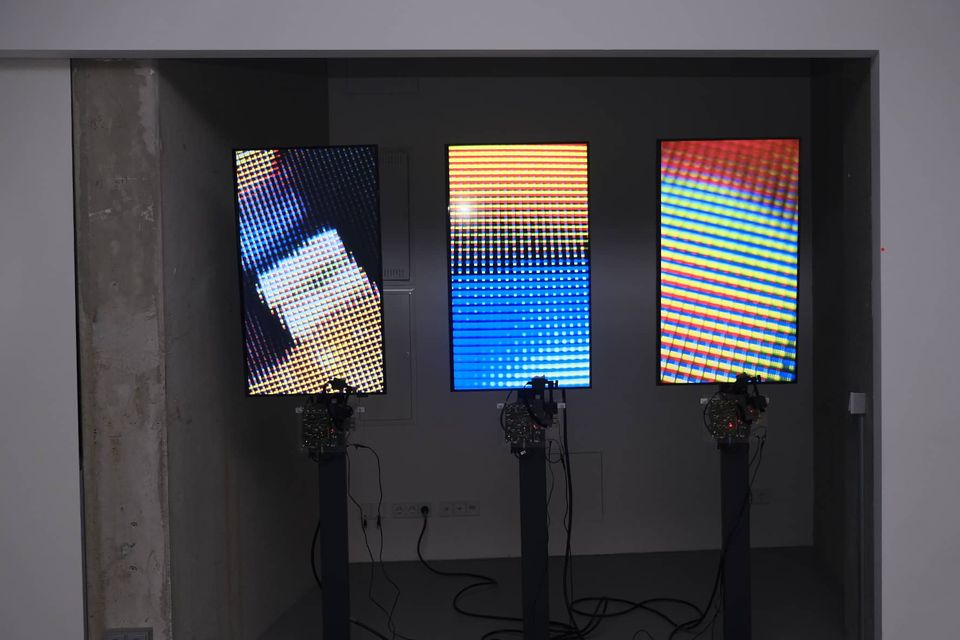
Courtesy Art Claims Impulse
The audio-video installation It's Organic If You Look Close Enough by artist Wolfgang Spahn aims to deconstruct the so-called perfect surface created in the virtual sphere by contemporary digital technology. By exploring the surface of OLED monitors through macro film, the camera makes visible the frayed edges of the Organic Light Emitting Diodes (OLEDs). This creates images that would not be visible to the naked eye: The supposedly homogeneous perfect squares are actually uniquely shaped, frayed and uneven when approached with the macro lens.
A triptych of three OLED monitors, each equipped with a Raspberry Pi camera, shows patterns created and re-created by macro-films of the frayed pixels. Thus, each monitor is both source and display of the patterns generated in an endless feedback loop. These patterns are manifold, as macrofilms magnify their objects, performatively generating changes in terms of structure, color, and dimension of the images.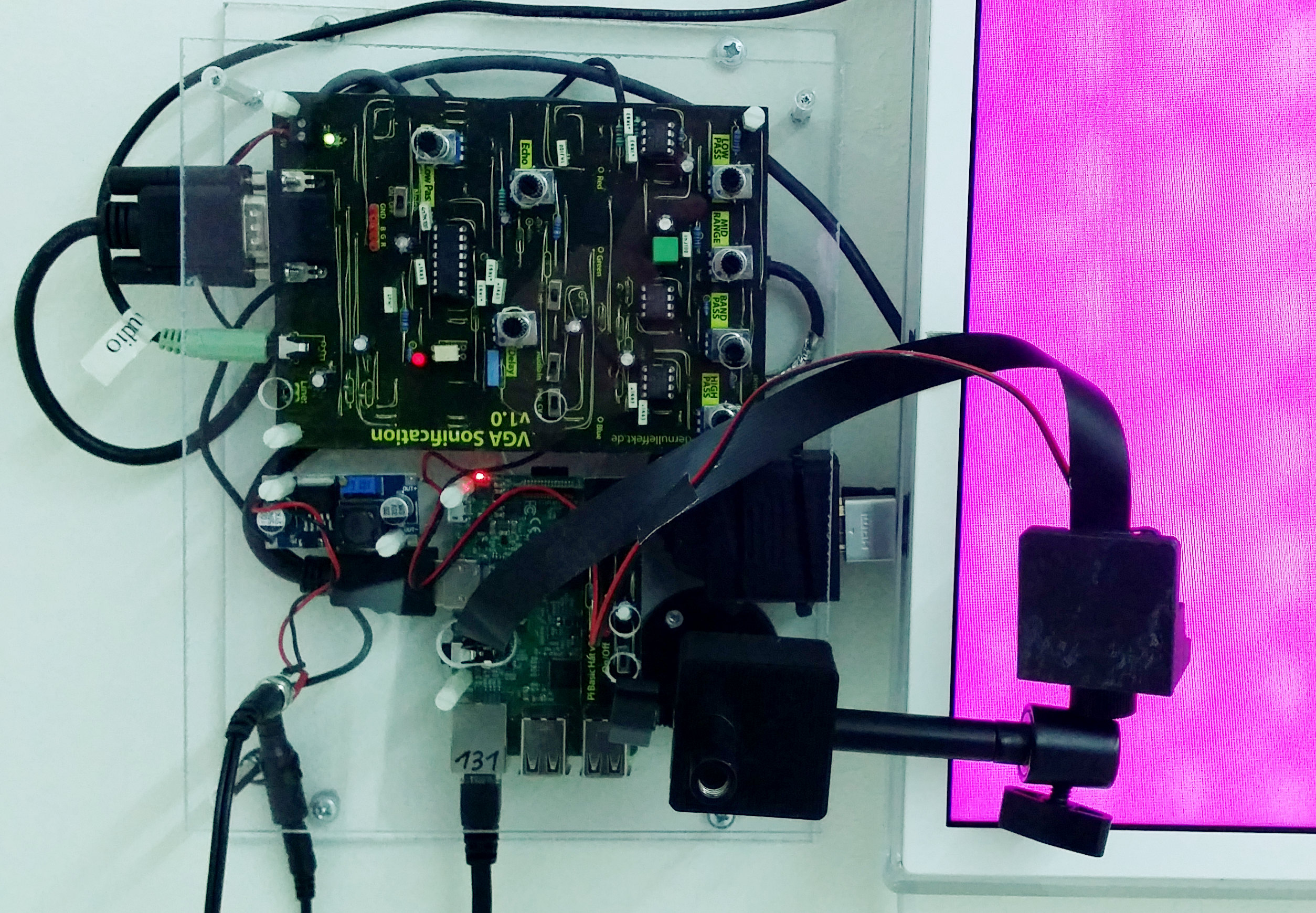
Courtesy of the Artist
In this respect, the installation speaks both to the organic structure of OLEDs and to the analog technology that is part of the digital interfaces. In doing so, it creates disillusionment: the purely digital surface can only exist as an abstract reality within the virtual sphere. The moment digital data is made accessible - whether through the use of monitors, cameras, or any technology that allows data to be stored, shared, or visualized - the pure digital surface is interrupted by the hardware of the interfaces, which always contains analog technology.
Nevertheless, the installation also includes virtual space. The VGA (Video Graphics Array) input signals of the OLED monitors are tracked and their audio amplified and streamed. In this respect, the imprecise sound resulting from the organic images will be publicly available in the virtual space. The sonification of the data can be understood as interference: organic material interferes with the perfect surface of the abstract virtual sphere.
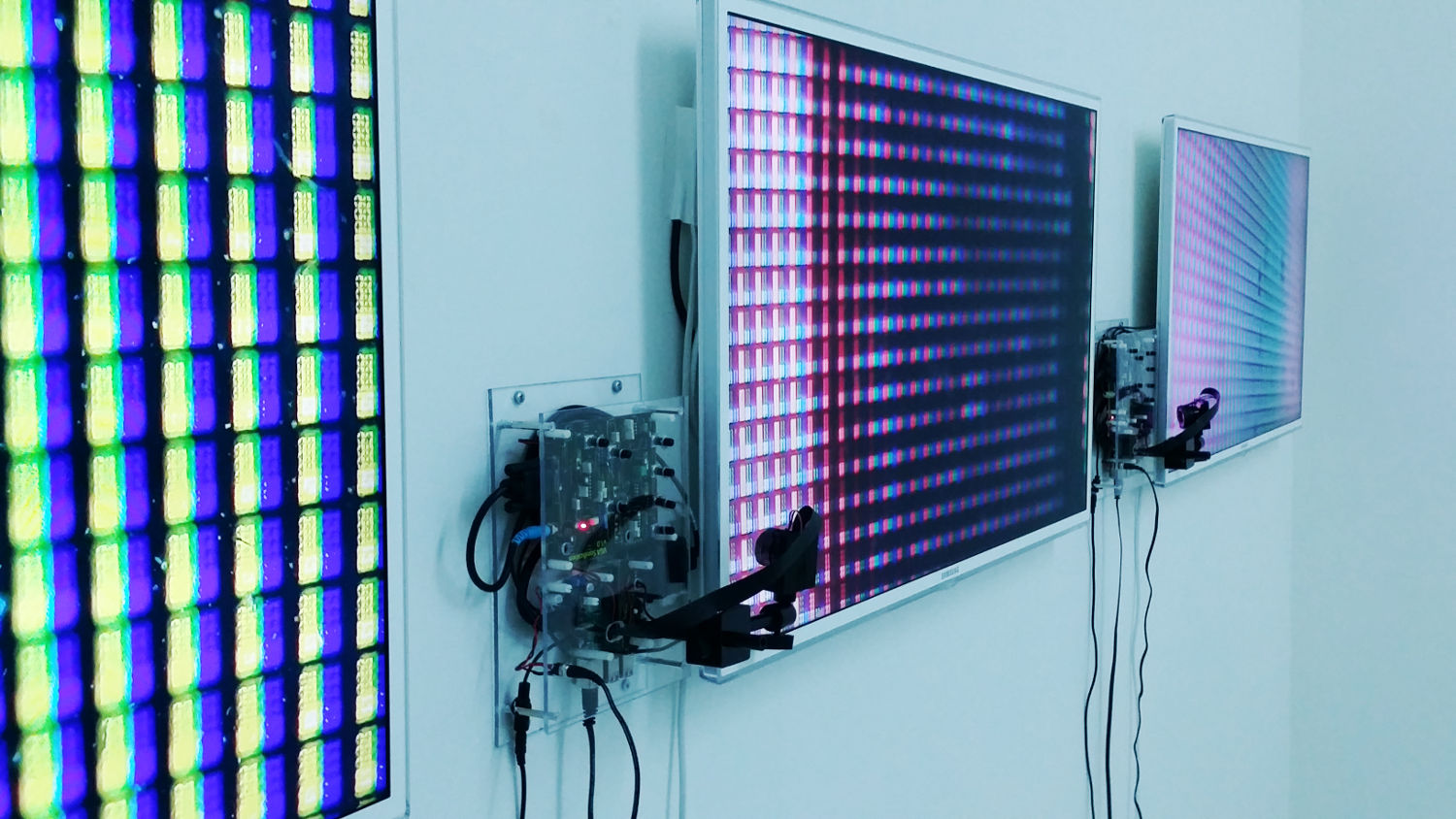
Courtesy of the Artist
Entagled Pixels
![]()
![]()
Noctilucent
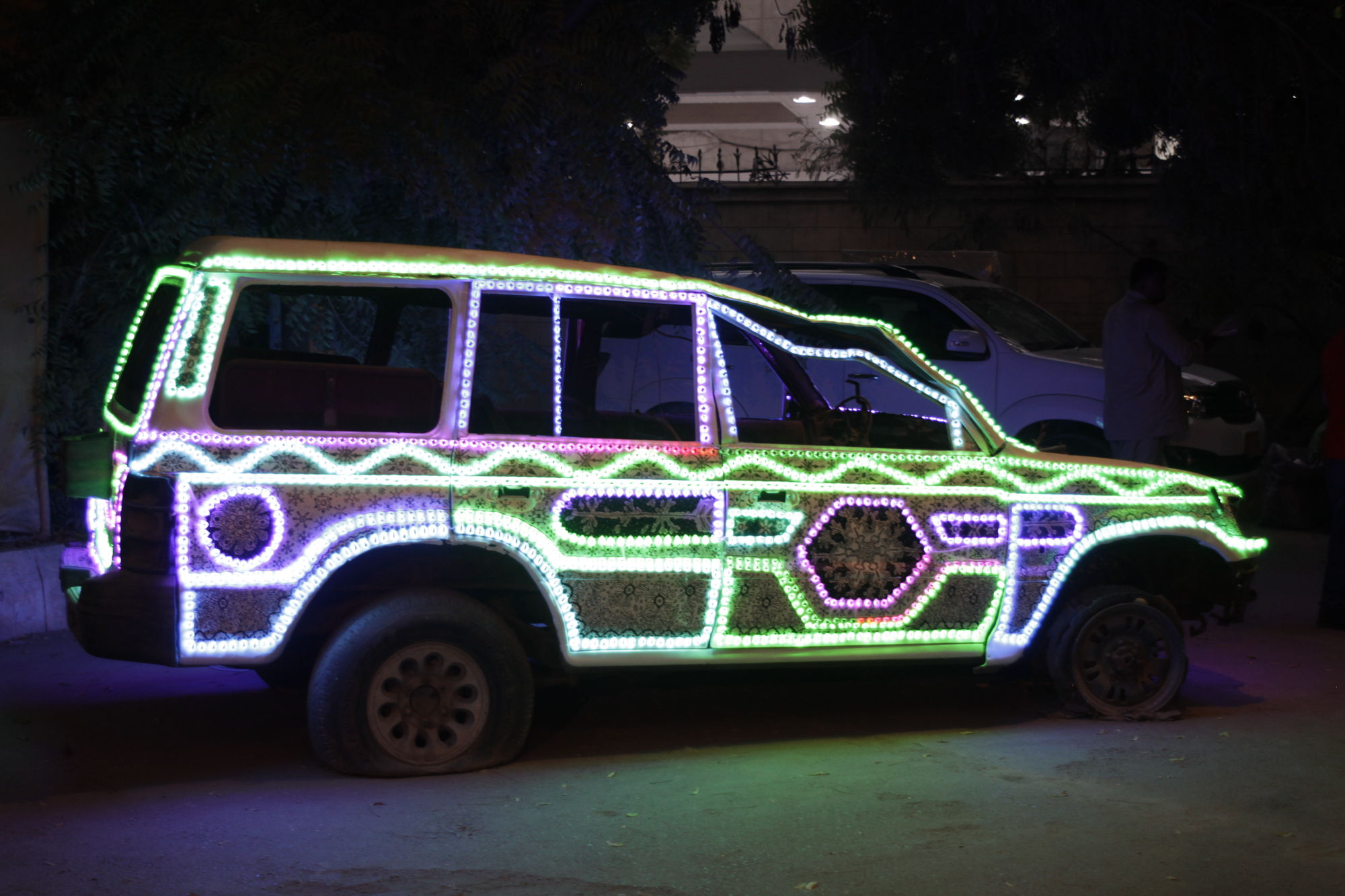

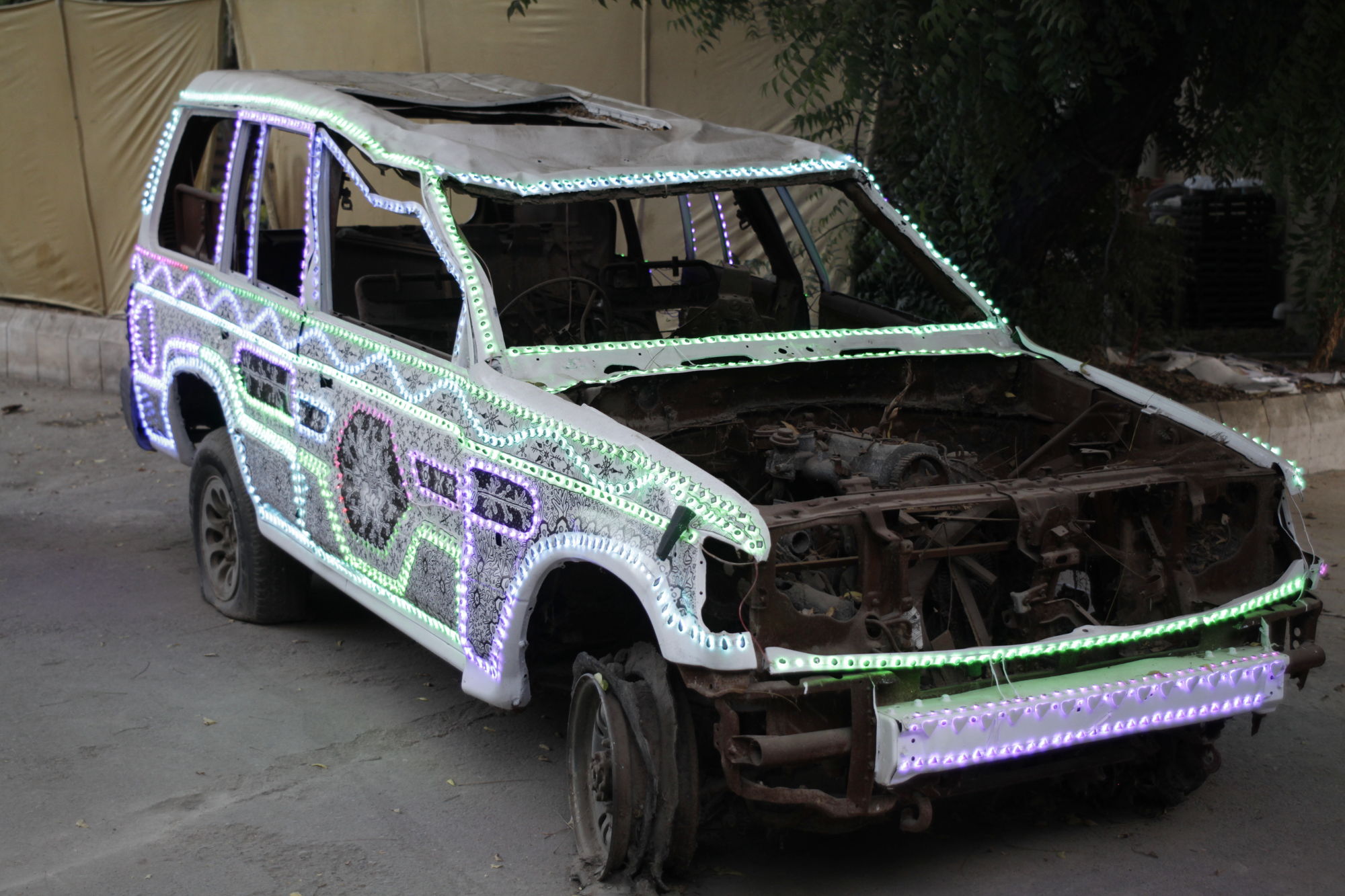
Bilder einer Ausstellung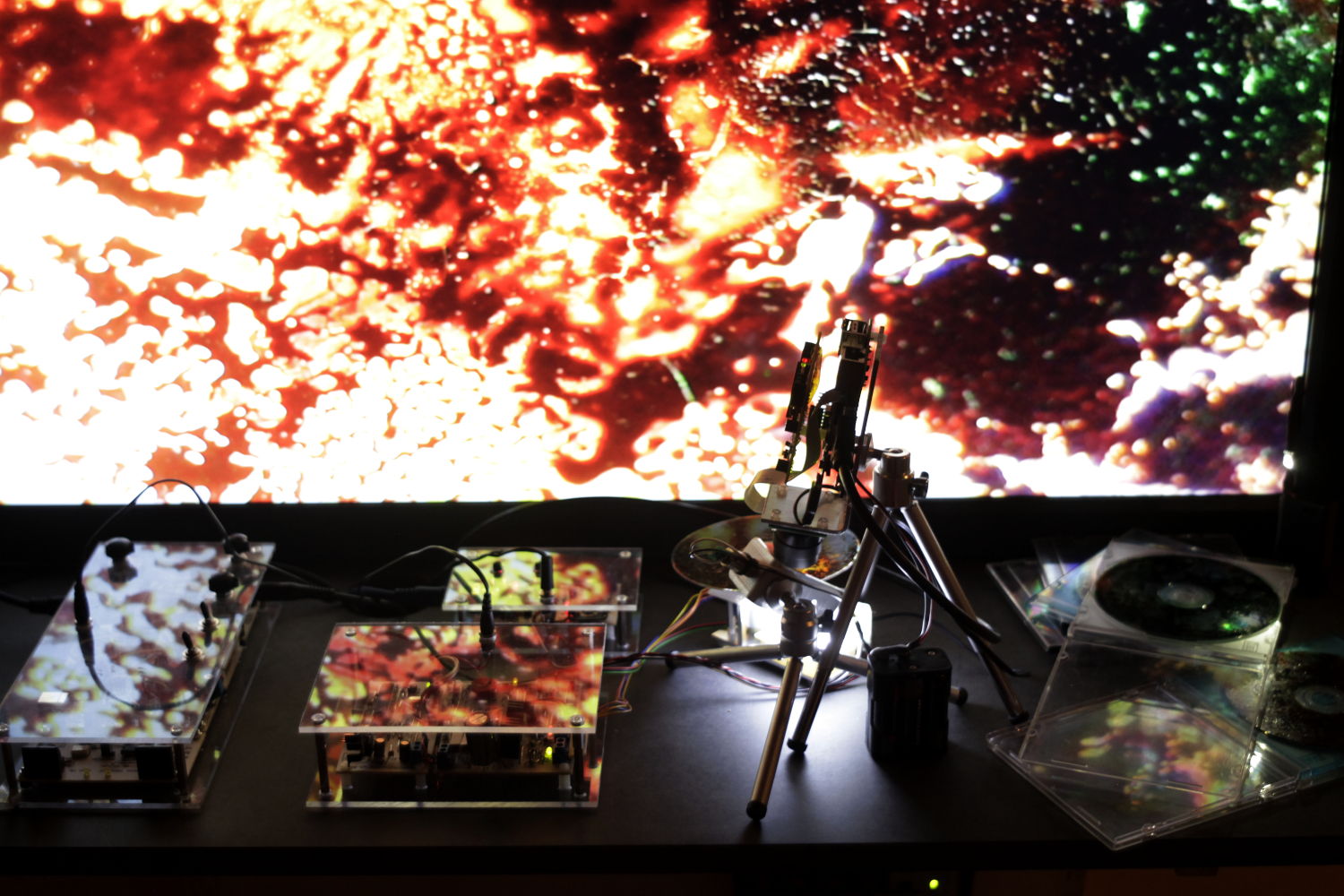
Courtesy of the Artist

Courtesy of the Artist
eine Klang-Bild Installation
von Wolfgang Spahn, 2014
Almost 100 years after the invention of the Intonarumori by futurist Luigi Russolo and the kinetic sculpture "Light-Space-Modulator" by artist and Bauhaus professor László Moholy-Nagy, the installation "Picture of an Exhibition" combines the functions of these two systems into a single machine.
Abstract generated projections correspond with equally abstract live generated sounds. Permanently moving patterns and artifacts emerge on a projection screen behind a laboratory-like structure. Parallel to this, a recurring auditory experience develops, reminiscent of rolling stones in a riverbed. Inspired by the program music "Pictures at an Exhibition" by Modest Mussorgski, the installation by
Wolfgang Spahn, the sound is generated directly from the image. A laser is used to scan the surface of a picture plate. The resulting light fluctuations are amplified and made audible. By means of an analog synthesizer circuit (bass drum of an 808) volume is added to the sound.

The rotating image disc is a chemical-physical color experiment created in miniature painting mode from finely pigmented substances and nano-liquids. A macro camera now films and enlarges this abstract image and projects it behind the installation. All the techniques used are the artist's own developments and are based on open hardware and software (www.dernulleffekt.de). The camera consists of the small Linux computer
Raspberry Pi. The control of the rotation is generated with a Pure Date patch on this computer.
Entropie
Entropy, an audio (noise)-visual performance
Both, image and sound are generated from different analog and digital self-developed machines. The development of the film / moving image began first with the artificial separation of these. Through the separation of the image and the sound it was only possible to create films. The artwork Entropy brings them together again and cancels the artificial separation. Entropy makes the data streams of the digital projector audible and creates an audio-visual presentation of the electromagnetic fields consisting of coils and motors.
CV
Solo Exhibitions
2019 “Self-Similar and Strange” Art Claims Impulse, Berlin, Germany
2018 „Maailmankaikkeus“ (with Antti Pussinen and Dominik Eggerman) Diskurs Berlin, Germany
2018 “Symbolic Grounding” (with Christian Faubel) Glasmoog KHM, Köln, Germany
2018 “Symbolic Grounding” (with Christian Faubel) Gallery Diskurs, Berlin, Germany
2013 “Directions“ IWALEWAHAUS, Bayreuth, Germany
2011 “Analog_ien“ Galerie Durynek und Kammler, Eichstätt, Germany
2009 “Asymmetische Systeme II: Eis Sprung” Galerie Ardes, Berlin, Germany
2005 “Klima - Wandler …und wo sind die Myzelien” Galerie 35, Berlin, Germany
2003 “Himmel und Hölle“, Galerie 35, Berlin, Germany
2002 “Wir bau´n uns einen Führerbunker“, Galerie 35, Berlin, Germany
2001 “buy.onic“, Hot Pixel Gallery, Berlin, Germany
2000 “Kinetische Lichtobjekte“, Kunstverein ACUD, Berlin, Germany
1998 “Malanggan und was von SERO sonst noch übrig blieb“ Kunsthaus Tacheles, Berlin, Germany
1996 „Wechselstrombildung“, Orange Age, Berlin, Germany
Group Exhibitions
2019 “KB19 - The Second Karachi Biennale” Karachi Pakistan
2019 “Open Labs” Science Gallery Dublin, Irland
2019 “Feedback #4: Marshall McLuhan and the Art” College for Creative Studies, Detroit, USA and University of Windsor, Canada
2018-19 Marler Medienkunst-Preis, Skulpturenmuseum Glaskasten Marl, Germany
2018 “More than Human” Museum Kesselhaus, Berlin, Germany
2017 Karachi Biennale 17, Pakistan
2017 Bienal de Artes Mediales, Santiago de Chile, Chile
2017 “Feedback #1: Marshall McLuhan and the Art” West Den Haag, Netherland
2017 “Bodenlos – Vilem Flusser und die Künste” Galerie AMU, Prague
2017 “Remix Wagner” Wagner Museum Bayreuth, Germany
2017 “Double Road” Maximilian Forum, München, Germany
2016 “T2F” Karachi, Pakistan
2016 “Venkatappa Gallery” Bangalore, India
2016 „Montag Modus“ Collegium Hungaricum, Berlin, Germany
2015-16 “Bodenlos – Vilem Flusser und die Künste” Akademie der Künste, Berlin, Germany
2015 “Musrara Mix” Jerusalem, Israel
2014 “Dangerous“ Spreeviera Galerie, Berlin, Germany
2013 “LAC“ ESC, Graz, Austria
2012 “Crash of Test“ Westwerk, Hamburg, Germany
2012 “B E A U T I F U L !“ Private View, Berlin, Germany
2010 “The Year We make Contakt - Media Scape Zagreb 2010“ Croatian Association of Artistsm, Zagreb, Republic of Croatia
2010 10th Biennial of Miniature Art, Gornji Milanovac, Republic of Serbia
2010 “Kunstraum Mausoleum” St. Matthäus Kirchhof, Berlin, Germany
2010 “ubiquitous oscillations” General Public, Berlin, Germany
2009 “Born Digital” Toonkammer, Utrecht, Netherland
2009 “Licht und Schatten” Schloss Rheinsberg, Rheinsberg, Germany
2009 “The Art of the Overhead” Malmö, Sweden
2008 “Between Fiction and Fact“ Galerie der Künste, Berlin, Germany
2007 “Am Rande“ Ausstellungszentrum Hellersdorf, Berlin, Germany
2007 “Strictly Berlin / Targets of Opportunity”, Galerie der Künste, Berlin, Germany
2006 “Figures of Motion”, Schloss Plüschow, Schwerin, Germany
2005 International Biennale of Contemporary Art, National Gallery Prague, Czech Republic
2004 “Politische Ästhetik” Takt Kunstraum, Berlin, Germany
2003 “Cmimi - Muslim Mulliqi Prize” The Kosovo Art Gallery in Pristina, Republic of Kosovo
2002 “Arte in Contemporanea” Modena, Italy
2002 “Reservois VI“, Wasserspeicher Prenzlauer Berg, Berlin, Germany
2002 “Hicetnunc” Villa Manin di Passariano, Italy
2001 “Junge Kunst 2”, Löwenpalais Stiftung Starke, Berlin, Germany
2000 “Arti Visive 3” Genua, Italy
1999 “Beyond Art“, Manes Gallery, Prague, Czech Republic
1999 “Expression of Youth“, Urbino, Italy
1999 “Imaginäres Gestern”, Kunsthaus Tacheles, Berlin, Germany
1998 “Licht, Ton und Grafik“ Städtische Galerie Riesa, Riesa, Germany
Mediafestivals
2018 PIKSEL18, Bergen, Norway
2018 “Monitoring” 35. Kasseler Dokfest, Kassel, Germany
2017 EMAF - European Media Art Festival, Osnabrück, Germany
2016 Shiny Toys, Mühlheim, Germany
2016 AMRO 16 Linz, Austria
2015 PIKSEL15, Bergen, Norway
2015 B-Seite, Mannheim, Germany
2014 Transmediale14, Berlin, Germany
2014 AMRO 14, Linz Austria
2012 Transmediale 2k+12, Berlin, Germany
2011 Pixxelpoint, Nova Gorica, Republic of Slovenia
2009 PIXEL09, Bergen, Norway
2009 “Tiefklang” Internationales Klangkunstfest, Berlin, Germany
2008 “farb_laut” Internationales Klangkunstfest, Berlin, Germany
2007 Directors Lounge, Berlin, Germany
Commissioned Artwork
2015 “Southern Cross, Remediation” IwalewaHaus Bayreuth, Germany
Residencies
2018 Maggelan 2020, Punta Arenas, Chile
2017-18 Stiftung Künstlerdorf Schöppingen, Germany
2016 BangaloREsidency - Srishti Institute of Art, Bangalore, India
Publications
- Marler Medienkunst-Preis, Wienand 2018
- Art of Wagnis Christoph Schlingensief's Crossing of Wagner and Africa, 2017
- Transmedial 2k+12, Transmedial, 2012
- 10. International Biennial of Miniature Art. The Cultural Centre of Gornji Milanovac, 2010
- Internationales Klangkunstfest farb_laut, Thomas Gerwin 2008
- International Biennale of Contemporary Art, National Gallery in Prague, 2005
- Cmimi - Muslim Mulliqi - Prize, The Kosovo Art Gallery, 2003
- Reservoir VI, Förderband Kulturinitiative Berlin, 2002
- HicetnuncEdizioni Biblioteca Dell'Immagine, 2002
- Arte in Contemporanea, Emilia Romagna 2002
- Arte Visive 3, Neos Edizioni 2000
Workshops & Teatching
2019 “Sound and Pattern in Analog Neural Networks”, Sound Studies and Sonic Art, University of the Art Berlin, Germany
2019 I, Machine, and Energy Harvesting (with Mindaugas Gapševičius), Shared Habitats, MO Museum, Vilnius, Lithuania
2019 “Zvuk i obrasci analognih neuronskih mreža – Neuro Pop”, Radiona, Zagreb, Republic of Croatia
2019 “Analog Neural Networks”, Alan Wildeman Centre for Creative Arts, Windsor, Canada
2019 “Hand-Crank Energy Harvester”, Orangi Pilot Project, Karachi, Pakistan
2018 “Sound Synthesis and MIDI with the Arduino” Sound Studies and Sonic Arts, University of the Art Berlin, Germany
2018 “Pop Neuron - An Analog Artificial Neuron Network”, Bauhaus-Universität Weimar, Germany
2018 “Weird Signal Processing”, PIKSEL18, Bergen, Norway
2018 “Paper Bits - An Analog Modular Synthesizer”, Knobs and Wires, München, Germany
2018 “Pop Neuron Workshop” (with Christian Faubel), Glasmoog KHM, Köln, Germany) 2018 “Unmapping VGA Signals” (with Antti Pussinen), Art Meets Radical Openness, Linz, Austria
2018 “Paper Bits – A Modular Analog Synthesizer”, Radiona, Zagreb, Republic of Croatia
2018 “Lichterscheinung - Neo Pixel in aktueller Bildkunst” Carl-von-Ossietzky University of Oldenburg, Germany
2018 “Paper-Bits Workshop”, Goethe-Institutand, Vila Flores and Audiovisual Sem Destino, Porto Alegre, Brazil
2018 “VGA-Hacking”, West Den Haag, Netherland
2017 “NEO PIXEL - paint with light” Karachin Biennale, Pakistan
2017 “Analoge Synthesizer”, BBK-Berlin, Germany
2017 “Kunst-Kamera mit dem Raspberry Pi”, BBK-Berlin, Germany
2016 “Internet of Art: Raspberry-Web-Cam” Carl-von-Ossietzky University of Oldenburg, Germany
2016 “Internet of Art - RasPi-Live-Cam”, University of Paderborn, Germany
2016 “Paper-Bits”, Ljudmila, Ljublijana, Republic of Slovenia
2016 “Embedded Platforms for Art - Raspberry Pi for Media Artists”, University of the Arts, Berlin, Germany
2016 “Interaktive und Generative Kunst mit dem Arduino”, University of the Arts, Berlin, Germany
2016 “The Sound of the Electro-Magnetic Smog”, Art Meets Radical Openness, Linz, Austria
2016 “Paper-Duino-Pictures”, Orangi Pilot Project, Karachi, Pakistan
2016 “Materialität im Digitalen mit dem Raspberry Pi”, University of Paderborn, Germany
2016 “Licht-Raum Modulator mit dem Arduino”, Carl-von-Ossietzky University of Oldenburg, Germany
2015 “Embedded Art System” (with Malte Steiner) PIKSEL15, Bergen, Norway
2015 “Paper-Synthesizer 201 - MIDI to Control Voltage” (with Antti Pussinen), Werkstatt Berlin, Germany
2015 “Licht-Raum Modulator mit dem Arduino”, Carl-von-Ossietzky University of Oldenburg, Germany
2015 “Materialität im Digitalen mit dem Raspberry Pi”, BBK-Berlin, Germany
2014 “Intermediale Ästhetik: Fusion von zeitgenössischen Praxen in Bildkunst und Medienkunst”, Carl-von-Ossietzky University of Oldenburg, Germany
2014 “Paper-Synthesizer 100 - Hard-Sync-Oscillator” (with Antti Pussinen), Werkstatt Berlin, Germany
2014 “Paper-Duino-Pi and Urban Measurement”, Art Meets Radical Openness, Linz, Austria
2014 “Kunst-Computer-Interaction mit dem Arduino”, BBK-Berlin, Germany
2013 “Licht-Raum-Modulator”, University of Paderborn, Germany
2012 “Digitale Selbstvermessung” Hybrid Platform, University of the Arts and the Technische Universität Berlin, Germany
2012 “Kunst-Computer-Interaktion mit Processing”, BBK-Berlin, Germany
2011 “Licht, Raum und Bewegung - Kinetik und Interaktivität mit dem Arduino”, University of Paderborn, Germany
2010 “Mouse & Keyboard Hack - PIKSEL10, Bergen, Norway

